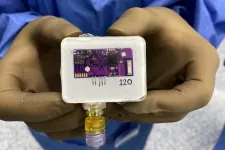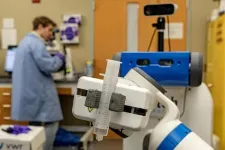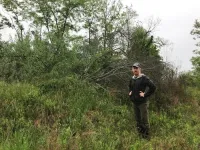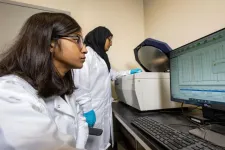(Press-News.org) The opioid epidemic claims more 70,000 lives each year in the U.S., and lifesaving interventions are urgently needed. Although naloxone, sold as an over-the-counter nasal spray or injectable, saves lives by quickly restoring normal breathing during an overdose, administrating the medication requires a knowledgeable bystander – limiting its lifesaving potential.
A team from Washington University School of Medicine in St. Louis and Northwestern University in Chicago has developed a device that may rescue people from overdose without bystander help. In animal studies, the researchers found that the implantable device detects an overdose, rapidly delivers naloxone to prevent death and can alert emergency first responders.
The findings are available Oct. 23 in Science Advances.
“Naloxone has saved many lives,” said Robert W. Gereau, PhD, the Dr. Seymour and Rose T. Brown Professor of Anesthesiology and director of the WashU Medicine Pain Center. “But during an overdose, people are often alone and unable to realize they are overdosing. If someone else is present, they need access to naloxone — also known as Narcan — and need to know how to use it within minutes. We identified an opportunity to save more lives by developing a device that quickly administers naloxone to at-risk individuals without human intervention.”
Prescription opioids – such as oxycodone – have helped people manage the physical and mental challenges of daily debilitating pain. But the addictive properties of painkillers can lead to their misuse and abuse, which are among the driving forces behind the opioid epidemic. In addition, cheap and easy-to-access synthetic drugs – fentanyl, for example – have flooded the illicit market. Such ultrapotent drugs have accelerated the rise in overdose deaths in the U.S. and were responsible for roughly 70% of such deaths in 2023.
The researchers worked with experts in engineering and material sciences led by John A. Rogers, PhD, a professor of materials science and engineering, biomedical engineering and neurological surgery at Northwestern University, to develop a device – the Naloximeter – that uses a drop in oxygen levels as a signal for a potential overdose. Overdosing on opioids leads to slow and shallow breathing. Minutes after the drugs begin to impact respiratory function, breathing stops. Implanted under the skin, the Naloximeter senses oxygen in the surrounding tissues, sending a warning notification to a mobile application if the levels drop below a threshold. If the user doesn’t abort the rescue process within 30 seconds, the device releases stored naloxone.
The researchers implanted the device in the neck, chest or back of small and large animals. The device detected signs of overdose within a minute of dropping oxygen levels, and all animals fully recovered within five minutes of receiving naloxone from the devices.
Naloxone displaces harmful opioids from receptors on the surface of brain cells, altering the cells’ activity. But the drug doesn’t stick around; when the opioids reoccupy and reactivate the receptors, overdose symptoms can return. To provide additional support, the device relays an emergency alert to first responders.
“An additional benefit of calling first responders is that it helps people re-engage with health-care providers,” said Jose Moron-Concepcion, PhD, the Henry E. Mallinckrodt Professor of Anesthesiology at WashU Medicine and an author on the study. “We want to save people from dying from an overdose and also reduce harm from opioids by helping people access the resources and treatments to prevent future overdoses from occurring.”
The researchers were awarded a patent – with some help from the Office of Technology Management at WashU – to protect the intellectual property of the device. They are evolving the technology while also looking for industry partners in preparation for deployment on a larger scale and testing of the device in clinical trials with people.
“The Naloximeter is a proof-of-concept platform that isn’t limited to the opioid crisis,” said Joanna Ciatti, a graduate student in Rogers’ lab. “This technology has far-reaching implications for those threatened by other emergent medical conditions such as anaphylaxis or epilepsy. Our study lays important groundwork for future clinical translation. We hope others in the field can build off of these findings to help make autonomous rescue devices a reality.”
Ciatti JL, Vazquez-Guardado A, Brings VE, Park J, Ruyle B, Ober RA, McLuckie AJ, Talcott MR, Carter EA, Burrell AR, Sponenburg RA, Trueb J, Gupta P, Kim J, Avila R, Seong M, Slivicki RA, Kaplan MA, Villalpando-Hernandez B, Massaly N, Montana MC, Pet M, Huang Y, Morón JA, Gereau IV RW, Rogers JA. An autonomous implantable device for the prevention of death from opioid overdose. Science Advances. Oct. 23, 2024.
This work was supported by the National Institutes of Health (NIH) through the Helping to End Addiction Long-Term (HEAL) Initiative, grant numbers UG3DA050303 and UH3DA050303; the National Science Foundation Graduate Research Fellowship, grant number DGE-2234667; North Carolina State University, grant number 201473-02139; the NIH, grant number T32GM108539. The content is solely the responsibility of the authors and does not necessarily represent the views of the NIH.
Ciatti JL, Vazquez-Guardado A, Brings VE, Ruyle B, Morón JA, Gereau IV RW, Rogers JA have been awarded a patent (number: WO2022261492A1) based on the research described in this manuscript.
About Washington University School of Medicine
WashU Medicine is a global leader in academic medicine, including biomedical research, patient care and educational programs with 2,900 faculty. Its National Institutes of Health (NIH) research funding portfolio is the second largest among U.S. medical schools and has grown 56% in the last seven years. Together with institutional investment, WashU Medicine commits well over $1 billion annually to basic and clinical research innovation and training. Its faculty practice is consistently within the top five in the country, with more than 1,900 faculty physicians practicing at 130 locations and who are also the medical staffs of Barnes-Jewish and St. Louis Children’s hospitals of BJC HealthCare. WashU Medicine has a storied history in MD/PhD training, recently dedicated $100 million to scholarships and curriculum renewal for its medical students, and is home to top-notch training programs in every medical subspecialty as well as physical therapy, occupational therapy, and audiology and communications sciences.
END
Implantable device may prevent death from opioid overdose
Device delivers naloxone upon sensing drop in respiration, animal study shows
2024-10-23
ELSE PRESS RELEASES FROM THIS DATE:
Half of young adults support prison time for non-consensual condom removal
2024-10-23
Almost nine in 10 young adults in the UK believe that removing a condom during sex without the other person’s permission is sexual assault, and around half support prison time as a penalty, finds a new study by UCL researchers.
This is the first UK study to cover views on non-consensual condom removal. It is published in PLOS ONE and surveyed 1,729 people between the ages of 18 and 25, living in the UK.
Young people were chosen as the focus of the study as, out of all demographics, they use condoms the most.
The survey consisted of several examples of non-consensual condom removal, which ...
‘Paleo-robots’ to help scientists understand how fish started to walk on land
2024-10-23
The transition from water to land is one of the most significant events in the history of life on Earth. Now, a team of roboticists, palaeontologists and biologists is using robots to study how the ancestors of modern land animals transitioned from swimming to walking, about 390 million years ago.
Writing in the journal Science Robotics, the research team, led by the University of Cambridge, outline how ‘palaeo-inspired robotics’ could provide a valuable experimental approach to studying how the pectoral and pelvic fins of ancient fish evolved ...
Study: Robotic automation, AI will speed up scientific progress in science laboratories
2024-10-23
Science laboratories across disciplines—chemistry, biochemistry and materials science—are on the verge of a sweeping transformation as robotic automation and AI lead to faster and more precise experiments that unlock breakthroughs in fields like health, energy and electronics, according to UNC-Chapel Hill researchers in the paper, “Transforming Science Labs into Automated Factories of Discovery,” published in Science Robotics, the most prestigious journal covering robotics research.
“Today, the development of new molecules, materials and chemical systems requires ...
Paleontologists discover Colorado ‘swamp dweller’ that lived alongside dinosaurs
2024-10-23
A team of paleontologists working near Rangely, Colorado, has uncovered a new (or, more accurately, very old) state resident—a fossil mammal about the size of a muskrat that may have scurried through swamps during the Age of Dinosaurs.
The researchers, led by the University of Colorado Boulder’s Jaelyn Eberle, published their findings Oct. 23 in the journal PLOS ONE.
Eberle and her colleagues named their discovery, which they identified from a piece of jawbone and three molar teeth, Heleocola piceanus. The animal lived in Colorado roughly 70 to 75 million years ago—a time when a vast inland sea covered ...
Repeated COVID vaccines enhance mucosal immunity against the virus
2024-10-23
Ghent, October 24, 2024 – During the COVID pandemic, many of us have received multiple mRNA vaccines. New work by researchers at the VIB-UGent Center for Inflammation Research, Ghent University, and University Hospital Ghent, among others, has found that such repeated vaccinations lead to the presence of mucosal antibodies, for example, inside the nose. Their work appears in Science Translational Medicine.
Protective booster shots
Part of the global response strategy against the COVID pandemic involves the administration of booster shots, or ‘vaccine updates’ to ensure ...
MD Anderson expands arts experience program to enhance healing and well-being for patients
2024-10-23
HOUSTON ― As part of its ongoing commitment to patient comfort and healing, The University of Texas MD Anderson Cancer Center today announced a new focus on art to support the revitalization and expansion of its clinical facilities. This initiative will include the creation of a multisensory healing environment in both public spaces and patient care areas that are designed to prevent disease, promote health and foster well-being.
This transformative project aims to enhance every aspect of the patient experience, reinforcing MD Anderson's dedication to comprehensive ...
Students at Historically Black Colleges and Universities (HBCUs) face barriers to medical school admission, study finds
2024-10-23
CHAPEL HILL, N.C. – There are 45.3 million African Americans living in the United States and they represent 13.6 percent of the U.S. population, according to the U.S. Census Bureau. But only 5.7 percent of physicians in the United States self-identify as Black, despite multiple efforts over many years to increase the number of Black doctors.
A new study led by Jasmine Weiss, MD, MHS, FAAP, assistant professor of pediatrics in the UNC School of Medicine, describes the barriers to medical school admission that students at Historically Black Colleges and ...
Symbiosis in ancient Corals
2024-10-23
Coral reefs rank among the most biodiverse habitats on Earth and are often referred to as the rainforests of the sea. Modern reef building corals evolved in the Triassic Period around 250 million years ago. They can live in symbiosis with tiny organisms, often algae, that can carry out photosynthesis. This photosymbiosis is particularly beneficial in nutrient-poor waters because it helps the corals to recycle scarce nutrients.
Geological evidence reveals that corals already existed in the Devonian period, over 385 million ...
Researchers receive grant to study invasive autumn olive
2024-10-23
Almost a ubiquitous presence in landscapes across Southwest Virginia, the invasive autumn olive thrives.
But it’s not supposed to be here.
Autumn olive is known for its nitrogen-fixing ability, allowing it to thrive in poor soils and outcompete native plants. The shrub’s berries are edible, rich in antioxidants such as lycopene, and have a tart-sweet flavor. While its berries are beneficial for wildlife, the plant's aggressive spread disrupts local ecosystems, reducing biodiversity.
With a one-year grant from the Powell River ...
New research shows urine tests may detect early diseases
2024-10-23
Early detection is critical when it comes to curing diseases like cancer, but not everyone has easy access to screening tools. For problems in the genitourinary (GU) tract (which includes the kidneys, prostate, and bladder), health providers usually use a combination of screening tools, including blood tests, imaging, and physical examinations. Scientists are now working on an even simpler tool for screening illnesses before they become a problem – urine analysis.
According to a new study from scientists at The University of Texas at Arlington, Chan-Zuckerberg Biohub, and Stanford University, ...
LAST 30 PRESS RELEASES:
DNA tests reveal mysterious beluga family trees
Strategic sex: Alaska’s beluga whales swap mates for long-term survival
How early cell membranes may have shaped the origins of life
Cannabis legalization is driving increases in marijuana use among U.S. adults with historically lower consumption rates
Multifunctional dipoles enabling enhanced ionic and electronic transport for high‑energy batteries
Triboelectric nanogenerators for future space missions
Advancing energy development with MBene: Chemical mechanism, AI, and applications in energy storage and harvesting
Heteroatom‑coordinated Fe–N4 catalysts for enhanced oxygen reduction in alkaline seawater zinc‑air batteries
Meta-device for precision lateral displacement sensing
Plasma-guided mitotane for the treatment of adrenocortical carcinoma: adjuvant care to advanced disease
Theoretical study of laser-enhanced nuclear fusion reactions
Social environment impacts sleep quality
Optimized kinetic pathways of active hydrogen generation at Cu2O/Cu heterojunction interfaces to enhance nitrate electroreduction to ammonia
New design playbook could unlock next generation high energy lithium ion batteries
Drones reveal how feral horse units keep boundaries
New AI tool removes bottleneck in animal movement analysis
Bubble netting knowledge spread by immigrant humpback whales
Discovery of bats remarkable navigation strategy revealed in new study
Urban tributaries identified as major sources of plastic chemical pollution in the Yangtze River
UK glaucoma cases higher than expected and projected to reach 1.6 million+ by 2060
Type 2 diabetes prevention could more than halve carbon footprint linked to disease complications
Over 1 million estimated to have glaucoma in UK
Early treatment can delay rheumatoid arthritis for years
National childhood type 1 diabetes screening is effective and could prevent thousands of emergency diagnoses, UK study shows
Mix of different types of physical activity may be best for longer life
Continuous care from community-based midwives reduces risk of preterm birth by 45%
Otago experts propose fiber as first new essential nutrient in 50 years
Auburn Physics PhD student earns prestigious DOE Fellowship
AI tool helps you learn how autistic communication works
To show LGBTQ+ support, look beyond Pride Month
[Press-News.org] Implantable device may prevent death from opioid overdoseDevice delivers naloxone upon sensing drop in respiration, animal study shows







